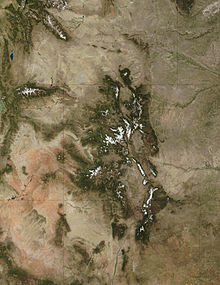| Southern Rocky Mountains | |
|---|---|
 | |
| Highest point | |
| Peak | Mount Elbert |
| Elevation | 14,440 feet (4401.2 m)[1] |
| Coordinates | 39°07′04″N 106°26′43″W / 39.1178°N 106.4454°W |
| Geography | |
 | |
| Country | United States |
| States | Colorado, New Mexico, Utah and Wyoming |
| Parent range | Rocky Mountains |

The Southern Rocky Mountains are a major subregion of the Rocky Mountains of North America located in the southeastern portion of the U.S. state of Wyoming, the central and western portions of Colorado, the northern portion of New Mexico, and extreme eastern portions of Utah. The Southern Rocky Mountains are also commonly known as the Southern Rockies, and since the highest peaks are located in the State of Colorado, they are sometimes known as the Colorado Rockies, although many important ranges and peaks rise in the other three states. The Southern Rockies include the highest mountain ranges of the Rocky Mountains and include all 30 of the highest major peaks of the Rockies.
The Southern Rocky Mountains are generally divided from the Western Rocky Mountains by the Green River and the Colorado River below the Green River. The Southern Rockies are divided from the Central Rocky Mountains by South Pass in Wyoming and the drainage running east from the pass down the Sweetwater River and the North Platte River; and the drainage running southwest from the pass down Pacific Creek and Sandy Creek to the Green River. This divide between the Southern Rockies and the Central Rockies provided the lowest elevation traverse of the Rocky Mountain region for the historic Oregon Trail, the Mormon Trail, and the California Trail. The southern end of the Rocky Mountains are considered to be the Jemez Mountains and the southern Sangre de Cristo Mountains of New Mexico. Mountains south of here in N.M. are classified as the Arizona/New Mexico Mountains using the EPA Level III Ecoregions System.
This article defines a significant summit as a summit with at least 100 meters (330 feet) of topographic prominence, and a major summit as a summit with at least 500 meters (1,600 feet) of topographic prominence. An ultra-prominent summit is a summit with at least 1,500 meters (4,900 feet) of topographic prominence.
All elevations in this article include an elevation adjustment from the National Geodetic Vertical Datum of 1929 (NGVD 29) to the North American Vertical Datum of 1988 (NAVD 88). For further information, please see this United States National Geodetic Survey note.
- ^ "MOUNT ELBERT". NGS Data Sheet. National Geodetic Survey, National Oceanic and Atmospheric Administration, United States Department of Commerce. 2019. Retrieved June 20, 2023.
